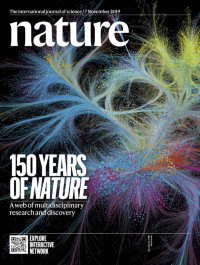Volume 575
-
No. 7784 28 November 2019
Twisted taleThe cover image shows tau protein (blue) accumulating inside neurons. Alongside amyloid-β, tau is believed to play a significant part in Alzheimer’s disease. Whereas amyloid-β accumulates in plaques, hyperphosphorylated tau aggregates in neurofibrillary tangles; these plaques and tangles contribute to neurodegeneration and cognitive decline. Activation in microglia of the NLRP3 inflammasome, a protein complex that is part of the body’s natural defences, is essential for amyloid-β plaque formation. In this week’s issue, Michael Heneka and his colleagues reveal that the NLRP3 inflammasome also helps to drive the formation of tau tangles. The team shows that tau tangles develop downstream of amyloid-β activating microglia and the NLRP3 inflammasome, lending support to the amyloid-cascade hypothesis in Alzheimer‘s disease. The researchers also find that tau itself can prompt activation of the inflammasome, hinting that there may be broader implications for other neurodegenerative diseases.
Career Guide
-
No. 7783 21 November 2019
Waves of mutationIn this week’s issue, Michael Desai and his colleagues demonstrate a barcoding strategy to visualize and track evolving mutations at high resolution in budding yeast. The result is a picture of the ‘travelling wave’ of adaptation, as seen on the cover, in which beneficial mutations compete for dominance (the lines represent separate lineages). The travelling wave shows how the distribution of fitness changes within the yeast population over time, and matches theoretical predictions. The researchers observe that clonal competition creates a dynamic ‘the-rich-get-richer’ effect, as fitness advantages acquired early in evolution drive a lineage to expand, increasing the chance of acquiring future mutations. The visualizations offer a fresh perspective on the factors that control the rate, predictability and molecular basis of adaptation.
Nature Index
-
No. 7782 14 November 2019
Game planStarCraft II is a science-fiction strategy game that is played competitively around the world. In it, players control one of three different alien races and must make strategic and tactical decisions that adapt to their opponents’ actions. The game has emerged as a key challenge for artificial intelligence because its complexity and multi-player challenges echo potential real-world applications. But AI programs have struggled to compete with human players, even in simplified versions of the game. In this week’s issue, Oriol Vinyals at DeepMind and his colleagues report that an AI program called AlphaStar has attained the level of Grandmaster for all three alien races in StarCraft II after competing against human players using the full online version of the game. AlphaStar now ranks among the top 0.2% of players in the game. The program achieved its success thanks to a multi-agent reinforcement learning algorithm in which several deep neural network agents compete against each other, generating a set of continually adapting strategies and counter-strategies.
Nature Outlook
-
No. 7781 7 November 2019
150 years of NatureThis issue marks the 150th anniversary of Nature — the first issue was published on 4 November 1869. The cover image visualizes the co-citation network for the journal. More than 88,000 papers published by Nature since 1900 are each represented by a dot, coloured by discipline. Papers are linked if another scientific paper cites both; the dot size reflects the number of these co-citation links. The complex network reveals the relationships between papers and captures the multidisciplinary scope of the journal. The story of key papers is revealed in a video, and a fully interactive version of this network can be explored at go.nature.com/n150int.




